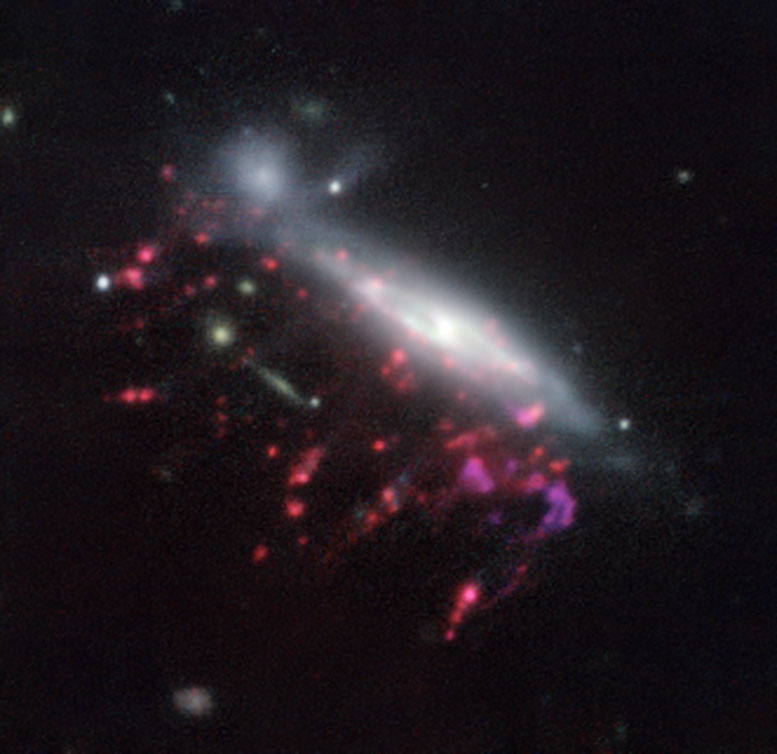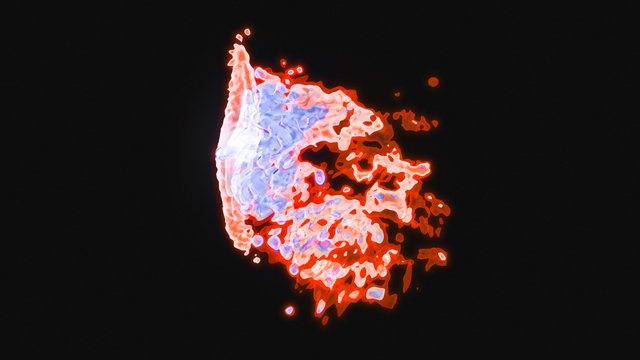ESO’s VLT Discovers New Way to Fuel Black Holes
This picture of one of the galaxies, nicknamed JO204, from the MUSE instrument on ESO’s Very Large Telescope in Chile, shows clearly how material is streaming out of the galaxy in long tendrils to the lower-left. Red shows the glow from ionised hydrogen gas and the whiter regions are where most of the stars in the galaxy are located. Some more distant galaxies are also visible. Credit: ESO/GASP collaboration

ESO’s Very Large Telescope has revealed a previously unknown way to fuel supermassive black holes.
Observations of “Jellyfish galaxies” show a new way to fuel black holes. It seems the mechanism that produces the tentacles of gas and newborn stars that give these galaxies their nickname also makes it possible for the gas to reach the central regions of the galaxies, feeding the black hole that lurks in each of them and causing it to shine brilliantly. The results appeared today in the journal Nature.
An Italian-led team of astronomers used the MUSE (Multi-Unit Spectroscopic Explorer) instrument on the Very Large Telescope (VLT) at ESO’s Paranal Observatory in Chile to study how gas can be stripped from galaxies. They focused on extreme examples of jellyfish galaxies in nearby galaxy clusters, named after the remarkable long “tentacles” of material that extend for tens of thousands of light-years beyond their galactic discs.

The tentacles of jellyfish galaxies are produced in galaxy clusters by a process called ram pressure stripping. Their mutual gravitational attraction causes galaxies to fall at high speed into galaxy clusters, where they encounter a hot, dense gas which acts like a powerful wind, forcing tails of gas out of the galaxy’s disc and triggering starbursts within it.
Six out of the seven jellyfish galaxies in the study were found to host a supermassive black hole at the center, feeding on the surrounding gas. This fraction is unexpectedly high — among galaxies in general the fraction is less than one in ten.
“This strong link between ram pressure stripping and active black holes was not predicted and has never been reported before,” said team leader Bianca Poggianti from the INAF-Astronomical Observatory of Padova in Italy. “It seems that the central black hole is being fed because some of the gas, rather than being removed, reaches the galaxy center.”
A long-standing question is why only a small fraction of supermassive black holes at the centres of galaxies are active. Supermassive black holes are present in almost all galaxies, so why are only a few accreting matter and shining brightly? These results reveal a previously unknown mechanism by which the black holes can be fed.
Congratulations @jpoudel! You have completed some achievement on Steemit and have been rewarded with new badge(s) :
Click on any badge to view your own Board of Honor on SteemitBoard.
For more information about SteemitBoard, click here
If you no longer want to receive notifications, reply to this comment with the word
STOP